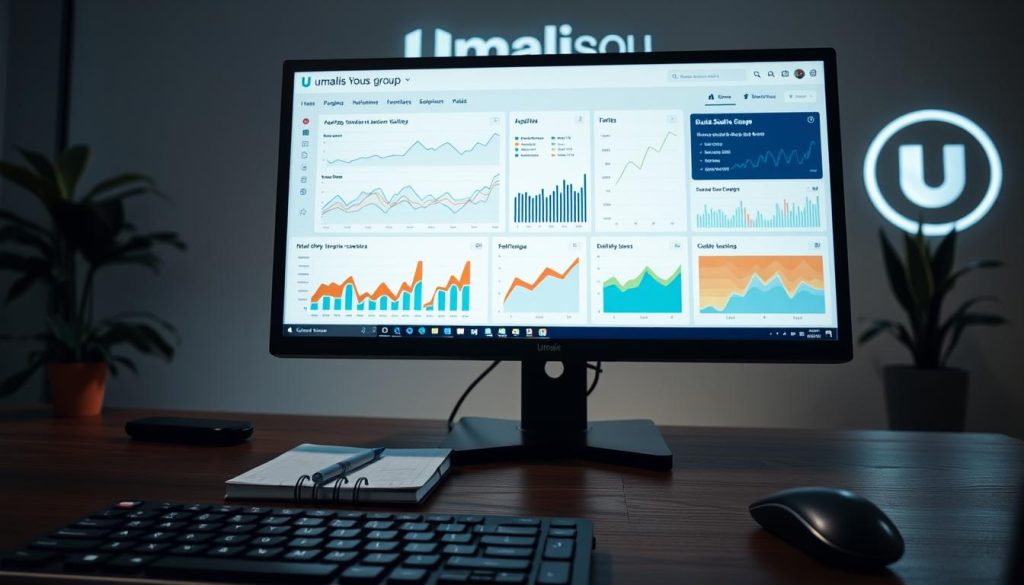Have you ever felt like your expertise gets lost in the noise of millions of online pages? As an independent professional, standing out in crowded search engine results isn’t just a goal—it’s the key to stability and growth. The right keyword research strategy can transform your visibility, turning your blog or site into a magnet for your ideal audience.
Think of monthly search volume and keyword difficulty as your compass. These metrics reveal what your clients truly seek—and how to deliver it. Tools like Google Search Console or platforms such as Umalis simplify this analysis, helping you identify high-value phrases with manageable competition. Whether you’re crafting a blog post or optimizing a service page, aligning with organic search traffic trends ensures your efforts yield real ROI.
We’ll guide you through both free and paid solutions, including Google’s Keyword Planner, to uncover long-tail opportunities. By the end of this guide, you’ll know how to rank on the first page of search engines while avoiding oversaturated terms. Let’s build a content strategy that works as hard as you do.
Table of Contents
Key Takeaways
- Keyword research is essential for aligning content with what your audience actively searches for.
- Metrics like search volume and difficulty determine a phrase’s potential value and feasibility.
- Free tools like Google Keyword Planner offer insights, while simulators like Umalis refine ROI predictions.
- Balancing high-traffic terms with niche phrases maximizes visibility without excessive competition.
- Long-tail keywords attract targeted leads, improving conversion rates and career stability.
Understanding Keyword Research Fundamentals
Imagine your website as a lighthouse guiding clients through a stormy digital sea. Effective strategies begin with knowing which signals to send. This starts with mapping the language your audience uses to find solutions.
What It Means and Why It Matters
At its core, this practice identifies phrases people type into search engines. Tools like Google Keyword Planner reveal terms with monthly search volume that matches your services. For example, a freelance designer might discover « brand identity packages » has steady demand but manageable competition.
Data shows 68% of online experiences start with a search engine. Aligning your content with these queries positions you as the answer clients seek. Metrics like click-through rates and cost-per-click help prioritize terms that drive meaningful traffic.
Decoding What Your Audience Wants
Search intent determines whether users want information, products, or local services. A query like « how to create a business plan » signals educational needs, while « hire project manager Paris » indicates buying intent. Platforms like Google Search Console categorize these patterns.
By analyzing top-performing pages for your target phrases, you uncover gaps in existing content. Combine this with long-tail keywords (3-5 word phrases) to attract visitors ready to engage. For instance, « best CRM for consultants » converts better than generic « CRM software. »
The Role of Keyword Research in SEO Strategy
Did you know websites aligning content with audience search habits see 3x faster ranking improvements? This isn’t luck—it’s strategy. Effective SEO relies on bridging the gap between what you offer and what clients actively seek. Tools like Google Keyword Planner decode this demand, turning vague ideas into actionable insights.
Turning Data into Client Connections
Every search query is a clue. For instance, a consultant optimizing for “freelance project management tools” might discover that “agile project management templates for consultants” has lower competition but higher conversion potential. By prioritizing these phrases, you answer specific needs while avoiding oversaturated topics.
“Content that mirrors real search behavior earns trust faster. It’s not just traffic—it’s relevance.”
Consider these metrics when planning your strategy:
| Keyword Type | Avg. Monthly Searches | Competition Level | Conversion Potential |
|---|---|---|---|
| High-Volume (e.g., « SEO tips ») | 10,000+ | High | Low |
| Long-Tail (e.g., « SEO for freelance consultants ») | 500-1,000 | Low | High |
To start, audit your existing pages using targeted keyword insights. For example, a French HR consultant reshaped their blog around “portage salarial avantages fiscaux,” tripling organic traffic in four months. Focus on phrases where your expertise meets unmet needs—this builds authority and client loyalty simultaneously.
Using Google Keyword Planner Effectively
Navigating the world of SEO tools can feel overwhelming, but Google Keyword Planner simplifies the journey. As a free resource integrated with Google Ads, it helps professionals uncover phrases their audience uses daily. Let’s explore how to harness its features while understanding its boundaries.
Getting Started with Google Keyword Planner
Begin by creating a Google Ads account—no payment required. Once logged in, access the tool through the « Planning » menu. The dashboard offers two primary functions:
- Discover New Terms: Enter broad topics related to your services (e.g., « freelance contracts »).
- Analyze Performance: Review monthly search ranges and competition levels for existing phrases.
The tool groups search volume into brackets like 1K-10K, which helps prioritize opportunities without overwhelming beginners. However, advanced users might need more precise data from paid alternatives.
| Feature | Strength | Limitation |
|---|---|---|
| Search Volume Data | Reveals trending topics | Shows ranges, not exact numbers |
| Competition Levels | Highlights low-competition phrases | Based on paid ads, not organic SEO |
Pair this tool with your website analytics to identify gaps. For example, if « portage salarial taux de charge » has steady searches but low visibility on your blog, create content addressing that exact phrase. Update your strategy quarterly as search trends evolve.
Exploring Alternative Keyword Research Tools

Choosing the right SEO tools can feel like navigating a crowded marketplace—but you don’t need a premium budget to start. While platforms like Google’s solution remain popular, dozens of specialized options now cater to different needs and skill levels.
Free vs. Premium: What’s Right for You?
Free tools like Ubersuggest or AnswerThePublic offer instant access to critical metrics. They reveal monthly search volume and basic competition levels, ideal for beginners testing SEO strategies. For example, Ubersuggest’s dashboard highlights long-tail phrases like “freelance contract templates for startups” with under 1,000 monthly searches—perfect for niche targeting.
Paid suites like Ahrefs or SEMrush go deeper. They track real-time ranking changes across countries and analyze competitors’ backlink profiles. A 2023 marketing report found professionals using premium tools save 6 hours weekly on data analysis.
“Free tools provide 80% of the value for 20% of the cost—ideal for solopreneurs.”
| Tool Type | Key Features | Export Limits | Ideal For |
|---|---|---|---|
| Free | Basic volume/difficulty scores | 100 results/day | Bloggers, new sites |
| Paid | Competitor tracking, trend forecasting | Unlimited | Agencies, scaling businesses |
Consider your goals: A consultant targeting local clients might use France-specific tools like 1.fr’s Suggesteur de Mots-Clés. Meanwhile, global teams benefit from SEMrush’s multilingual filters. Most platforms offer free trials—test several before committing.
Setting Up Your Keyword Research Process
Think of your content strategy as a garden—seed keywords are the roots that determine its growth. These core terms shape your entire SEO approach, guiding how you organize topics and connect with your audience. Start by listing services, products, or expertise areas central to your business. For example, a career coach might begin with « résumé optimization » or « interview preparation. »
From Brainstorming to Strategic Clusters
Group related terms into topic clusters to build content pillars. A financial consultant could categorize phrases like « retirement planning strategies » and « tax-efficient investments » under wealth management. Tools like Google Keyword Planner or Ubersuggest expand these seeds into subtopics, revealing gaps in your current content.
| Core Topic | Seed Keywords | Subtopic Examples |
|---|---|---|
| Freelance Contracts | « Template, » « Legal clauses » | « NDA for freelancers, » « Payment terms » |
| Portage Salarial | « Tax benefits, » « Charges » | « Calculating charges, » « URSSAF rates » |
Align phrases with user intent. Searches like « how to set freelance rates » indicate educational needs, while « hire SEO consultant Paris » targets immediate action. A 2023 SEMrush study found content aligned with intent earns 2.7x more organic traffic.
Follow these steps to build your foundation:
- List 5-10 core services or products
- Expand each with tools like AnswerThePublic
- Filter terms by search volume and local relevance
- Map clusters to existing blog posts or service pages
“Seed keywords act as signposts—they direct your content toward what matters most to your audience.”
By organizing terms early, you create a roadmap for future articles, emails, and service updates. This method ensures every piece of content reinforces your expertise while addressing real client needs.
Mastering Keyword Research Techniques
Unlocking the full potential of your online presence requires moving beyond basic search tactics. Advanced strategies blend competitor insights with trend forecasting to create content that outperforms rivals. Start by analyzing top-ranking pages in your niche—tools like Ahrefs reveal which terms drive their traffic.
Refine your list using three filters: monthly search volume, keyword difficulty, and regional relevance. For example, « freelance contract templates for IT consultants in France » combines specificity with local demand. This approach balances visibility with achievable rankings.
Competitor analysis transforms guesswork into strategy. Identify gaps where rivals rank for valuable terms but lack depth. A career coach might notice competitors missing « remote work negotiation strategies »—a prime opportunity to dominate untapped searches.
| Term Type | Avg. Searches | Competition |
|---|---|---|
| Broad (e.g., « marketing tips ») | 15,000 | High |
| Niche-Focused (e.g., « B2B LinkedIn marketing ») | 800 | Medium |
Validate findings across multiple platforms. Cross-reference Google Keyword Planner data with Ubersuggest to spot consistent patterns. Tools like AnswerThePublic add question-based phrases like « how to calculate portage salarial charges, » capturing specific client concerns.
« The best strategies evolve monthly. Treat keyword lists as living documents, not static checklists. »
Implement these steps for continuous improvement:
- Analyze 3 competitor sites quarterly using SEMrush
- Combine high-volume terms (1K+ searches) with long-tail variants
- Test localized phrases in blog titles and meta descriptions
By mastering these techniques, you’ll create content that adapts to market shifts while maintaining strong organic performance. Remember: sustainable visibility comes from precision, not just volume.
How to Conduct Keyword Research
Every successful SEO strategy begins with a solid foundation—your keyword research process. Follow this six-step framework to identify terms that align with your audience’s needs while maximizing organic growth potential.
- Brainstorm Core Topics: List services or expertise areas (e.g., « freelance contracts » or « tax optimization »). Use tools like AnswerThePublic to expand ideas into questions like « how to draft freelance contracts. »
- Validate Search Volume: Input terms into Google Keyword Planner. Prioritize phrases with 500-5K monthly searches—high enough for visibility but manageable for smaller sites.
- Analyze Competition: Check Google Search Console for pages already ranking. Look for gaps where your content can offer deeper value.
- Group by Intent: Separate informational queries (« how to calculate charges ») from transactional ones (« hire HR consultant Paris »).
- Test & Refine: Monitor traffic for 60 days using free tools like Ubersuggest. Replace underperforming terms quarterly.
For quick wins, focus on long-tail phrases with local relevance. A French consultant targeting « portage salarial charges calcul » might rank faster than broader terms.
| Tool | Purpose | Best For |
|---|---|---|
| Google Keyword Planner | Monthly search estimates | Initial validation |
| AnswerThePublic | Question-based phrases | Content ideas |
| Ubersuggest | Competitor analysis | Gap identification |
“Start with 10-15 high-potential terms per month,” advises a 2024 SEO trends report. Track click-through rates weekly and adjust meta descriptions to improve relevance. This methodical approach helps independent professionals build sustainable visibility without overwhelming effort.
Analyzing Search Volume and Competition Metrics

What separates fleeting visibility from lasting client connections? The answer lies in balancing two critical factors: demand and achievability. Tools like Google Keyword Planner provide foundational data, but true mastery comes from interpreting trends and competition levels together.
Understanding Monthly Search Volume and Trends
Monthly search volume estimates how often users seek specific phrases. For instance, « freelance contract templates France » might show 1,200 monthly searches. But ranges like 1K-10K require deeper analysis—check Google Trends for seasonal spikes or rising demand.
Seasonal patterns matter. A tax consultant might target « portage salarial charges » in Q1 when filings peak. Conversely, evergreen terms like « project management certification » maintain steady traffic year-round.
Evaluating Keyword Difficulty and Competition Levels
Competition scores (0-100) predict ranking effort. Scores below 40 indicate niches where quality content can thrive. For example, « IT consultant Lyon » (difficulty 35) offers better ROI potential than « consulting services » (difficulty 78).
Consider these benchmarks when planning:
| Keyword Type | Avg. Search Volume | Difficulty Score | ROI Potential |
|---|---|---|---|
| High Competition | 10,000+ | 70+ | Low |
| Low Competition | 300-800 | 20-40 | High |
Combine metrics for strategic choices. A marketing specialist might prioritize « B2B LinkedIn strategy Paris » (800 searches, difficulty 38) over broader terms. Update your list quarterly using tools like Ubersuggest to adapt to market shifts.
Understanding CPC and ROI in Keyword Planning
Think of keyword selection like investing—every choice impacts your professional growth. While organic search traffic remains free, cost-per-click (CPC) data reveals hidden opportunities. Higher CPC values often indicate terms with strong commercial intent, even if you’re not running ads.
CPC measures what advertisers pay per click for specific phrases. For example, « portage salarial taux de charge » might have a €4.50 CPC in France, signaling high demand among consultants. This metric helps prioritize terms where your content can compete with paid listings.
To estimate ROI, combine CPC with conversion rates. Tools like Google Keyword Planner show average bids alongside search volume. A phrase with 800 monthly searches and €3 CPC suggests €2,400 monthly ad spend in your niche—valuable insight for content positioning.
| Industry | Avg. CPC (€) | Organic Traffic Potential |
|---|---|---|
| Legal Services | €8.20 | High |
| Marketing | €4.10 | Medium |
| Career Coaching | €2.80 | Low |
Focus on terms where CPC and organic potential intersect. For instance, « freelance contract lawyer Paris » (€6.80 CPC) might attract clients willing to pay premium fees. Update your strategy quarterly as market values shift.
“High CPC terms often convert 3x faster organically—they’re already proven profit drivers.”
Even without paid campaigns, CPC data helps identify gaps. Prioritize phrases with moderate competition (20-40 difficulty score) and CPC above your industry average. This balance maximizes visibility while maintaining achievable rankings.
Optimizing Content with Strategic Keywords
Creating content that ranks well requires more than just inserting terms—it demands strategic alignment with how your audience thinks. The goal is to match search intent while maintaining natural, engaging writing. Here’s how to achieve that balance.
Seamless Integration Techniques
Start by placing primary phrases in critical areas:
- Title tags: Include your main term within 60 characters
- First paragraph: Naturally introduce the core topic
- Subheadings: Use variations to guide readers through sections
For example, a blog post targeting “freelance contract templates” might open with: “Drafting legally sound agreements is essential for independent professionals.” This addresses the query without forced repetition.
| Element | Keyword Use | Impact |
|---|---|---|
| Meta Description | Include primary + secondary terms | Boosts click-through rates |
| Header Tags (H2/H3) | 1-2 variations per section | Improves content structure |
| Alt Text | Describe images contextually | Enhances accessibility & SEO |
Tools like Google Search Console reveal which pages underperform. Update them by adding synonyms or related questions. A French consultant improved traffic 40% by optimizing “portage salarial taux charges” in existing guides.
“Content should answer questions, not just check SEO boxes. Readers stay when you prioritize clarity.”
Limit keyword density to 1-2%. Use tools like Hemingway Editor to simplify sentences. For local targeting, add region-specific terms like “consultant indépendant Paris” in headings and body text. This approach builds relevance without sacrificing readability.
Tips for Long-Tail Keyword Success
What if your expertise could attract clients who need exactly what you offer? Long-tail phrases—specific, multi-word terms—help you cut through generic competition. These targeted queries often reveal urgent needs, like « freelance contract lawyer for startups in Lyon » instead of vague « legal advice. »
Leveraging Niche and Long-Tail Phrases
Long-tail keywords act as precision tools. A financial consultant might target « retirement planning for freelance consultants in France » rather than broad « financial tips. » These phrases have lower monthly search volume but higher intent. A 2023 study found pages using long-tail terms convert 40% better than generic ones.
Tools like AnswerThePublic uncover question-based phrases. For example, « how to calculate portage salarial charges » addresses specific client concerns. Free platforms like Ubersuggest reveal subtopics within broader niches, helping you dominate underserved areas.
Balancing Low Volume with High Relevance
While long-tail terms attract fewer searches, they often convert faster. Compare these scenarios:
| Keyword Type | Avg. Searches | Conversion Rate |
|---|---|---|
| « Marketing Consultant » | 5,000 | 1.2% |
| « B2B LinkedIn Marketing Consultant Paris » | 300 | 8.7% |
A French HR consultant tripled inquiries by optimizing for « portage salarial charges calculation guide. » Prioritize phrases where your unique skills meet unmet needs. Combine 2-3 long-tail terms per blog post to build topical authority without over-optimization.
« Specificity builds trust. Clients choose experts who speak their language, not generalists. »
Update your list quarterly using tools like SEMrush’s Keyword Magic Tool. Track phrases with rising local interest, such as « freelance VAT rules France 2024. » This approach keeps your content aligned with evolving client needs while maintaining steady organic growth.
Implementing SEO Best Practices Using Keyword Data
Ever wonder why some pages rank higher despite similar content? The answer lies in strategic optimization. Combining keyword insights with technical precision ensures your expertise reaches the right audience. Start by structuring content around clusters—groups of related terms like « freelance contract templates » and « NDA clauses for consultants. »
- Use primary phrases in title tags and meta descriptions (keep titles under 60 characters)
- Organize subtopics with H2/H3 headers containing semantic variations
- Link related articles using anchor text like « calculating portage salarial charges »
Tools like Google Search Console reveal underperforming pages. For example, a French HR site boosted traffic 55% by adding « URSSAF rates 2024 » to headers and meta tags. Update content quarterly based on search trend shifts.
| On-Page Factor | Off-Page Factor | Impact Level |
|---|---|---|
| Header Optimization | Backlink Quality | High |
| Internal Linking | Social Shares | Medium |
Balance technical tweaks with audience needs. A 2024 study found pages combining keyword alignment with fast load times rank 2.3x faster. Audit your site monthly—fix broken links, compress images, and refresh outdated statistics. Remember: sustainable SEO blends data-driven choices with genuine value.
Local and International Keyword Considerations
Cultural nuances shape how clients search for solutions—what works in Paris may fall flat in Montréal. Tailoring your strategy to regional preferences ensures your expertise resonates globally while addressing local needs. Start by analyzing search behavior patterns specific to your target regions.
Adapting to Regional Search Trends
Google’s location filters reveal striking differences. For instance, French professionals often search for “portage salarial avantages” while German freelancers use “freiberufler steuern optimieren.” Tools like SEMrush’s Market Explorer track these variations, helping you prioritize regionally relevant phrases.
Consider these adjustments for cross-border strategies:
- Localize spellings and idioms: “CV writing services” becomes “rédaction CV professionnel” in France
- Align with legal terms: “freelance contract templates” transforms into “contrat de prestation de services”
- Integrate city-specific modifiers: “SEO consultant” → “consultant SEO Paris”
| Region | High-Value Phrase | Monthly Searches |
|---|---|---|
| France | “calcul charges portage salarial” | 1,200 |
| Canada | “freelance contract lawyer Toronto” | 850 |
Global campaigns require layered planning. A career coach targeting Europe might create separate content clusters for “Lebenslauf Optimierung” (Germany) and “CV Europass” (France). Tools like mastering keyword research simplify this process by comparing search volumes across languages.
“Localized content drives 72% higher engagement than generic translations. Precision beats scale in global markets.”
Regularly update your lists using country-specific data from Google Trends. For example, “auto-entrepreneur 2024” surged in France post-tax reforms. Pair these insights with cultural awareness—avoid idioms that don’t translate well, like “hit the ground running” in Japanese markets.
Conclusion
Building a sustainable online presence starts with understanding what your audience truly needs. By aligning your content with precise search intent, you create pathways for clients to discover your expertise effortlessly. Tools like Google Search Console and Ubersuggest simplify this process, revealing high-value phrases that balance search volume and competition.
Focus on long-tail terms that reflect specific challenges, such as “calculating freelance tax rates in France.” These phrases attract visitors ready to engage, boosting conversion rates while avoiding oversaturated markets. Integrating this data into your blog or service pages ensures your efforts yield measurable ROI over time.
For professionals seeking stability, mastering search engine positioning isn’t optional—it’s foundational. Start by auditing your existing content, then refine it using the strategies outlined here. Consistency transforms initial visibility into lasting authority.
Ready to elevate your digital impact? Apply these methods today, and watch your organic growth reflect the value you provide. Your expertise deserves to be seen—make sure it’s found.
FAQ
Why is understanding search intent crucial for content strategy?
Analyzing user intent ensures your articles address real questions your audience asks. This alignment improves engagement, boosts rankings in Google Search results, and builds trust with professionals seeking reliable solutions.
How does Google Keyword Planner help independent professionals?
The tool reveals monthly search volume and competition levels for phrases in your niche. By identifying high-value terms with manageable CPC, you prioritize content that drives organic traffic and maximizes ROI for your services.
When should freelancers use long-tail phrases over broad terms?
Long-tail keywords attract qualified leads despite lower search volume. For example, « certified tax consultant for remote workers » targets specific needs better than generic terms, reducing competition while increasing conversion potential.
What metrics matter most when evaluating keyword difficulty?
Focus on domain authority of ranking pages, backlink profiles, and content depth. Tools like Ahrefs or SEMrush show if you can realistically compete using your existing blog authority and resource depth.
How do regional search trends impact local service providers?
Adapting phrases like « IT support in Miami » versus « cloud services USA » ensures visibility in target markets. Use Google Search Console’s geographic data to align with local queries while maintaining global SEO best practices.
Can free tools replace paid keyword research platforms?
Free options like Ubersuggest work for initial discovery, but paid tools like Moz Pro offer detailed search volume difficulty analysis and competitor gap tracking—critical for scaling professional content strategies efficiently.





